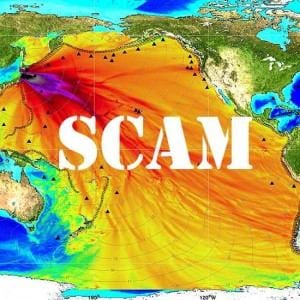Travel News
Travelers, Don’t Believe the Fukushima Scam
 Have you seen a photo circulating the Internet that warns you to get as far from the West Coast as soon as possible? Take a moment before you plan your escape or abandon your travel plans and understand the real facts behind the Fukushima scam.
Have you seen a photo circulating the Internet that warns you to get as far from the West Coast as soon as possible? Take a moment before you plan your escape or abandon your travel plans and understand the real facts behind the Fukushima scam.
Recently, a University of New South Wales model has been appearing around the Internet. According to that model, the brunt of radiation from the Fukushima power plant meltdown in Japan will hit the West Coast in April of this year, finally normalizing in 2021.
Travelers are expressing concern about harmful levels of radiation in the seafood and seawater in the Pacific.
“I’m afraid about having to cancel this trip,” one TripAdvisor user fretted.
Should you be afraid too? Absolutely not.
To be clear, radiation leaks at Fukushima are indeed a problem; radioactivity continues to leak into the immediate area and water. However, the problem will remain in the Japanese city. Ken Buesseler of the Woods Hole Oceanographic Institute explains,
“Because of the dilution that occurs even a short distance from Fukushima, we do not have a concern about the levels of cesium and other radionuclides in fish off the West Coast of the U.S.”
Buesseler also confirms that radiation in ocean water and debris will be far lower than the radiation that naturally occurs in the Pacific, so it will be safe for any water activity. To illustrate his point, Buesseler explains that whenever his team is just off the Fukushima coastline collecting test samples, “our biggest problem is filtering out natural radionuclides” to find traces of the Fukushima radiation.
For those who are particularly worried about fresh seafood (especially tuna), the Proceedings of the National Academy of Sciences released a report in April 2013 concluding:
“This study shows that the committed effective dose received by humans based on a year’s average consumption of contaminated Pacific bluefin tuna from the Fukushima accident is comparable to, or less than, the dose we routinely obtain from naturally occurring radio-nuclides in many food items, medical treatments, air travel, or other background sources.
Bottom line: You’ll likely get more radiation from your transcontinental flight than what you eat or do on your trip to the Pacific Coast.
Numbers are often cited to stoke worry, such as the fact that 80,000 gallons of irradiated water is pouring into the Pacific per day. Without context, it’s easy to be a scaremonger. Eighty thousand gallons is only one-eighth of an Olympic swimming pool. If you consider the size of the Pacific, one Olympic pool every eight days is hardly staggering.
Also be wary of sleights of hand. Take the well-circulated picture above that supposedly shows radiation levels sweeping across the Pacific in alarming red and orange colors. It’s not. This is, in fact, a picture showing wave heights of the tsunami immediately after the 2011 earthquake that caused the nuclear plant meltdown.
No need to reroute trips, stock up on iodine tablets, or wear rubber boots when you walk along the beach. Enjoy stuffing yourself with fresh tuna on that boat excursion (just watch out for the mercury!).
By Cody Brooks for PeterGreenberg.com












